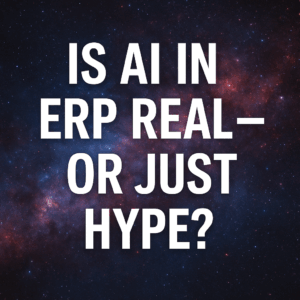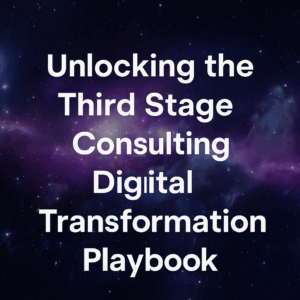Today we’re going to focus on some of the things you need to do to get ready for your implementation. For most of you reading this, going through a S/4HANA implementation is a considerable transformation, perhaps the most significant transformation your organization has been through. You will need a strong foundation in place before beginning. What are some of the things you can be doing to get prepared? Here is everything you need to know.
To get started, we’ll cover precisely what SAP system implementation is and what we mean by implementation readiness. Then, we’ll talk about why it’s so crucial to organizations to include in their strategies. I’ll provide an overview of an implementation readiness framework and an implementation readiness plan that we, at Third Stage, often use as a starting point for our clients that are going through or about to go through a S/4HANA implementation.
It’s essential to look at digital transformation initiatives and what some of those transformation enablers for an existing system are. Indeed, the S/4HANA technology is something that is a crucial enabler for your transformation. In addition to that, you also have implementation partners, your SAP systems integrator, other outside consulting firms you might be working with, as well other vendors such as your company and your internal resources. When you look at the layers of transformation, you have four primary layers:
- The Process
- The Technology
- The People or Organizational Change
- The Business Operations
Table of Contents
ToggleWhat is So Important about SAP Implementation Readiness?
To get started, we’ll cover precisely what SAP implementation is and what we mean by implementation readiness. Then, we’ll talk about why it’s so crucial to organizations to include in their strategies. I’ll provide an overview of an implementation readiness framework and an implementation readiness plan that we,at Third Stage, often use as a starting point for our clients that are going through or about to go through a S/4HANA implementation.
It’s essential to look at digital transformation initiatives and what some of those transformation enablers are. Indeed, the S/4HANA technology is something that is a crucial enabler for your transformation. In addition to that, you also have implementation partners, your system integrator, other outside consulting firms you might be working with, as well as your company and your internal resources. When you look at the layers of transformation, you have four primary layers:
- the Process
- The Technology
- The People or Organizational Change
- The Business Operations

Key Takeaway:
One of the key takeaways from the Four layers above is that project success is heavily dependent on your company, and the things you do prior to implementation. When we look at SAP failures, and some of the expert witness cases that we’ve been involved with over the years, a lot of times it’s the decisions that weren’t made appropriately during the implementation readiness stage or business objectives that weren’t clearly specified that lead to problems later on.
Success and failure can largely be traced back to what you do and how well you handle the implementation readiness component of your SAP project. Beyond that, in terms of looking at why implementation readiness is so important, it saves you time and money. If you think about it, you’re going to have a system integrator or a reseller that’s going to come in with their SAP functional technical resources, and they are ultimately going to send a small army of people to help deploy the software.
Risks
Once they land on site, the meter is running and every hour and day that goes by that you’re spending making decisions and trying to get alignment within your organization it’s costing you time and money. The more time and money you spend upfront during the implementation readiness stage, the more smoothly your project is going to go and the better use of your external and internal resources. It also mitigates risk.
A big risk of SAP software projects is not having the right level of involvement from your internal people, and not having the business process and organizational change sides of things figured out, and most importantly not having a SAP solution manager on your side. It does mitigate the risk of failure and it also ensures alignment which is a positive. In the end, make sure that from the executive team all the way down to the project execution, you want to have alignment throughout the organization.
Major SAP Components
When we look at S/4HANA transformation readiness, there are five major components and four of them are mentioned above. We added a fifth one here which is strategic and executive alignment. To recap, we have alignment and ensuring that your executive team is working together strategically. The others are operational readiness, technology readiness, as well as people readiness, and project governance. These are the main components of an implementation readiness that can get your business ready for a transformation.
Some of the objectives that we see coming out of an implementation readiness engagement or the implementation readiness phase is going to be to will prepare the company to optimally engage with a system integrator and ultimately preparing your internal team for change and engaging leading to progress and learning.

Project Ownership
Ownership is important for any project you work on. What we’re trying to do here is create awareness and education, mobilize the project team to gain alignment, and prepare for the system integrator activities that are required to happen during the implementation stage. Typically, when we’re working with clients during the implementation readiness phase of a project, there are three different parties involved here.
- Your organization owns the project, ensuring that your internal resources are provided to the project by making key decisions and important business decisions that need to be made.
- You have your system integrator or your VAR
- A reseller who specializes presumably in S/4HANA who has the functional technical expertise of SAP who is able to transfer some of that knowledge to you and help mobilize the external technology and functional team members.
When we’re working with clients in these types of engagements at Third Stage, we’re providing somewhat of an extension of our client’s resources in terms of capacity and capabilities.
The Process
It is important to ensure that some of the preparatory activities are happening and we’re taking some of that off the client’s plate and also providing implementation readiness co-responsibility with the company. We work side-by-side with this company and oftentimes the system integrator as well early on, to ensure that we are preparing for the implementation and we have the strategy clearly outlined.
This whole process enables us to provide an independent project quality assurance and organizational change management role beginning early on before the implementation of new system ever starts. It also allows us to address some of the non-SAP project roles that the system integrator isn’t able to provide. When we look at a sample implementation readiness plan for this particular client that, we can put together a six-month readiness phase leading into their implementation.
SAP is a multibillion-dollar company, a global organization, the most significant transformation that the company has ever done. It was essential to ensure that the organization had everything in place so when the system integrator showed up at the end of month six, everything could run smoothly. A small army of consultants showed up, and we wanted to make the best use of their time, and those critical operational decisions had been made.
This was important because this meant we’ve secured the executive alignment that we required. We have a PMO established, some project governance set up, and an organizational change management plan in place. When we look at the implementation Readiness Review, we see that some of the outputs coming out of the process will feed into the performance. This new implementation readiness phase will ensure that we have a strong linkage to the actual implementation activities.
These outputs and deliverables that come out of the implementation readiness stage are intended to augment, not replace things that happen during implementation. It is meant to provide the first iterations, some of the key foundational decisions that are going to happen within each of these workstreams, leading into the implementation activities that are fit to standard required coming into that.
The first area of the first workstream that we look at within executive alignment is strategic and executive alignment. We look at this to ensure that the executives are aligned in terms of their overall project strategy and that we have the stakeholder assessment defined, as well as the executive in management communications. It is important to make sure that the communications plan is in place and that the executives are starting to get on board with the overall project.
The Implementation
At the end of the implementation readiness, we have something called the Stage-Gate Review. This is where we make that go-no-go decision of, are we ready to start implementation?
- Do we have the right decisions in place?
- Are we ready for the system integrator to arrive and to start working with us?
These are some of the key things that happen there.
When I look at what causes failure or problems during SAP projects, frequently, it’s because we haven’t articulated what’s going through the executive’s heads in terms of what they want to accomplish as an organization and with the overall project. We haven’t translated those into specific project goals and objectives.
The objective in this workstream of implementation readiness is to ensure that we have that sort of clarity, and we’ve translated the goals and objectives into things that are specific to the project. We also look at operational readiness. So, a lot of times, companies find that when they begin their S/4HANA implementation, many decisions need to be made around how they will run their business. Some of these are tough decisions to make.
Decision Making
We want to bring forward as many of these decisions pre-implementation as we can because these are strategic decisions, They’re not decisions necessarily, that are going to be driven by how S/4HANA is configured out of the box. These are key business decisions that we need to make as an organization that is independent of S/4HANA. Now, having said that, there are certainly are certain business functions and processes that are going to be dependent on S/4HANA, those you set aside and say, we will deal with those during implementation.
We also want to do the same with lower priority business processes, things that are not competitive advantages of ours or their commodity-based business processes. For the aspects that are strategic to the company, their competitive advantages, strategic differentiators, the benefits and things where S/4HANA provides a certain amount of flexibility in terms of how it can handle the functionality. We want to make sure we define those decisions early on in the process.
Where do we go from here? We start to look at things that we can start rolling out now, process and procedure types of changes that we can roll out in phase zero, or things that we can start changing now, even before SAP is implemented. We often find that somewhere between 30 and 50% of process improvements we identify during an SAP project, you can actually start rolling out ahead of time, which makes things easier from an operational organizational perspective.
You do not want to force all the changes all at once within the organization. You also need to look at people’s readiness. During this pre-implementation, or this implementation readiness stage, we’re looking at the skills and competencies that you have on your staff now, and what you’re going to need going forward. We also start building the organizational change plan in the team so that by the time the project starts, we have our entire organizational change plan in the team so that by the time the project starts, we have our entire OCM plan and team.
Today, we have actually kick-started the organizational change management activities at the more strategic level. One of the important things that oftentimes gets overlooked from an organizational change management perspective is typically system integrators treat organizational change management is more of tactical software-based change management. During implementation readiness, you want to be asking yourself four strategic change management questions:
- How are jobs going to be impacted?
- Do we need to change roles and responsibilities?
- Do we have to rewrite job descriptions? Are we redefining how people are reporting to one another?
- Are we consolidating business processes?
These are major decisions that if you try to make and do during the SAP project or throughout the formal implementation, and one of two things will happen. One,
- You’re going to rush through those decisions and probably settle on the way things are now because it’s easier as the time is ticking.
- You end up not implementing the changes because you’re rushed to get through the project.

Project Planning
The sooner we can pull these activities forward, the more effective your organizational change management is going to be. Especially when you get to the more tactical change management, which is typically what the system integrators focus on things like training and communications related to the usage of S/4HANA, versus the more strategic initiatives.
There is also technical readiness. This is the fourth of five workstreams within implementation readiness. Tactical readiness is where we look at your current infrastructure and put together a migration plan of how are we going to move from decommissioning all your outdated legacy systems and all the historical data and integrations.
- How are we going to migrate that over to SAP?
- What’s the timing going to look like?
- What’s the interim in between phases of the rollout presuming you’re doing a phased rollout?
- What are the interim integration points and things that we need to have in place?
Data migration is typically on the critical path to completion in a timely implementation. We start some of that data cleansing and mapping early on during implementation readiness. Finally, we also look at the IT organization itself, ensuring that we look at the competencies and skills that the IT organization has internally, and looking at the training and skills development that will be required for your internal IT organization to support SAP going forward.
Are You Ready?
In the end, we really start to mobilize that SAP Center of Excellence concept during implementation readiness to ensure that you take more ownership and control the project and that you’re not relying too much on outside consultants. Your IT department can be more educated and more sophisticated and being able to be more of a true partner with your system integrator rather than deferring to them too much because they have all the knowledge, and you don’t. Knowledge is power. This really gives your IT department a leg up on getting the be IT skill sets that they need to support the deployment of this nature.
Finally, we have project governance and planning. This is where we start to get the project charter, the project team in place, we develop the overall implementation plan, think of it as your program management plan that includes, not just your system integrator, but activities for your business users, internal resources and any other third parties that you’re going to pull in.
That’s a bit of an overview of implementation readiness and how it supports your SAP project.
This is something that we love to discuss we’ve done a lot of this for clients over the years for their S/4HANA implementations as well as for other implementations related to Microsoft Dynamics and Oracle ERP systems and other systems.
Hopefully, these tips can help as you venture into your SAP project or any digital transformation. If you’d like more customized feedback on SAP S/4HANA best practices for your specific organization, feel free to contact me directly. I am happy to be an informal sounding board for your project and throughout your business transformation journey.





